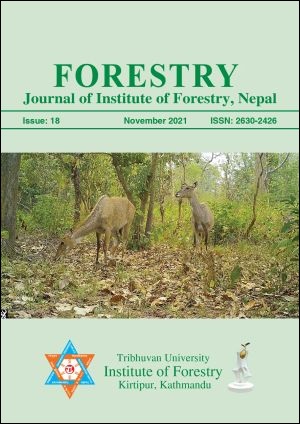Status of Invasive Alien Plant Species in Urban Forest of Hetauda, Nepal
DOI:
https://doi.org/10.3126/forestry.v18i01.41764Keywords:
Diversity, Invasive Alien Plant Species, Relative abundance, Transect survey, NepalAbstract
This paper explores the status of Invasive Alien Plant Species in an urban forest of Hetauda, Nepal. The study is based on a quadrate survey (130 quadrants) within the transect line at an interval of 30 m within different six habitat types. This study identified a total of 22 invasive alien plant species representing 20 genera and 12 families out of recorded 26 species representing 24 genera and 15 families in the country. This study identified four species namely Chromolaena odorata, Eichhornia crassipes, Lantana camara and Mikania micrantha in the study area that were listed as the world’s 100 worst invasive species. The invasion was found to be negatively correlated with canopy cover. The higher the canopy cover; the lower the abundance of invasive alien species. Regarding the habitat type, settlement area had the highest number of invasive species followed by forest and roadside. Mikania micrantha, Lantana camara, Ageratum houstonianum and Chromolaena odorata were mostly abundant in forest whereas Eichhornia crassipes was highly abundant in wetlands. Mikania micrantha was mostly abundant in settlement area and Senna tora was confined to open land. The relative abundance of Ageratum conyzoides, Senna occidentalis, Ageratum adenophora, Leersia hexandra, Mimosa pudica, Bidens pilosa, Oxalis latifolia, Ipomoea carnea, Amaranthus spinosus, Argemone mexicana, Esosphaerum suaveolens were lower.
Downloads
Downloads
Published
How to Cite
Issue
Section
License
© Tribhuvan University, Institute of Forestry




